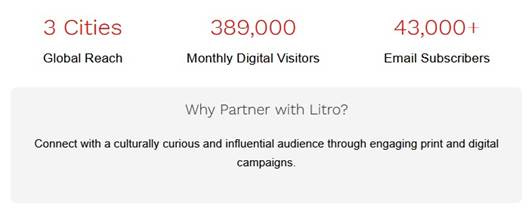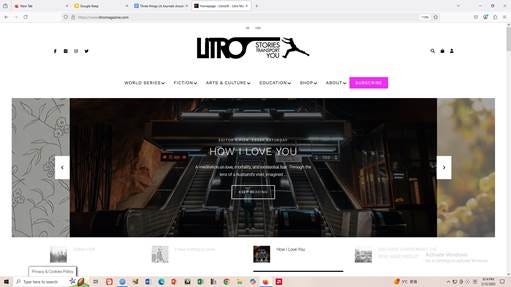Transparency, Promotion, and Design: Tools for Building Strong Lit Mags
"For those who care about marketing and readership..."
Welcome to our weekly column offering perspectives on lit mag publishing, with contributions from readers, writers and editors around the world.
I am extremely grateful for the hard work of the editorial teams who have read my essays and stories—even those who rejected them. I know that editors put a great deal of effort into the production of their magazines, and I also know that they receive little more than reputational brownie points. I imagine their role is further complicated by a rotating staff of part-time volunteers and student apprentices who, in effect, learn to run a publication for the first time each and every year. Under such conditions, it’s a miracle that they publish even a single issue once a year, let alone two, three, or four in the same short time span.
That being said, no matter how hard an editorial team works, and no matter how highly polished their reputation for excellence, almost every literary journal has room for improvement. This is especially true in a market bursting at the seams with publishing opportunities. Writers might not know it, but it’s a seller’s market, albeit one which doesn’t pay. But because this market doesn’t pay, managing editors need to find ways to differentiate their journals and attract the best writing. For years and years journals have relied on the same signifiers of reputation: extensive mastheads and long lists of their most famous writers as well as proximity to university MFA programs. However, there are other ways to build a solid reputation, and even the most reputable journals should put them into practice.
Below are three successful strategies which a handful of literary journals currently implement, but which more should notice. My hope in describing these good practices is that more journals will put them into place and thereby improve the reputation and professionalism of the industry as a whole.
1. Transparency
Two journals who have published my writing—Litro Magazine and Panorama Journal—both do one thing that even some of the highest ranking journals don’t, that is, they publish transparent statistics about their readership.
Litro, for example, states that they get 389,000 visitors a month and have over 43,000 email subscribers. If we are to believe these numbers, they are absolutely astounding, but even if we approximate a lower estimate, reducing the number of visitors a month by roughly two-thirds to account for the likely potential of a single person visiting the site on a home PC, a work PC, and a mobile phone, then Litro would still have monthly traffic that adds up to 129,667 visitors—an excellent number of potential readers for any short story or essay.
Regardless of how the numbers are reported, transparency, like the type Litro practices, makes it more likely that writers will submit their best work, and improve the reputation of the journal through pure, unadulterated literary merit. For example, when I submitted my essay “How I Love You,” I was drawn to the knowledge that a readership already existed. This made Litro far more attractive than it would have otherwise been. Too many other journals are effectively black holes with no acknowledged engagement whatsoever, a fact which doesn’t improve their reputations in the slightest.
Too many other journals are effectively black holes with no acknowledged engagement whatsoever…
Another journal that posts healthy statistics about their site is Panorama Journal, the journal that hosts my first-ever published essay, “An Acquaintance with Geumjeong Mountain.” Not only does Panorama list their monthly site visitations, which range between 50,000 and 100,000 as stated in a recent Duotrope interview with Editor Matthew Webb, but they also break this number down by country showing that the United States takes the most interest in their journal with 46% of their readers living stateside. This is further delineated by city, showing that despite a majority U.S. readership, London, England is the city with the highest readership, coming in at 7% overall. This data might be too granular for some, but in the right hands this information could help a writer target submissions to markets where they want to be read, making a journal a better fit for worthwhile writers.
For those who care about marketing and readership, web traffic statistics are incredibly valuable. I would love to see more of my favorite journals produce year-end reflections full of insightful data (submission numbers, acceptance rates, page views, etc.). Readers like data. Don’t we all go crazy when Spotify Wrapped and Strava Year in Sport release their yearly statistics? I know I do. Most of us would surely love to know which stories in our favorite literary journals had the most traction.
Of course, aggregating such data might be difficult, but it would benefit the journal just as much as it would inform their audience. How so? Imagine a journal using such data to surface the work on their site that had the most engagement. This could show prospective contributors which types of stories were most popular, and those insights could then be used to develop a more distinct editorial style—one which is modeled rather than explained.
Don’t you, writers, want to know exactly what a journals’ editorial team values?
2. Promotion
Promotion is another key strategy employed by successful literary journals who care about their reputations. I’ve been lucky enough that three of the six journals who have published my work have done an excellent job promoting it. The Inquisitive Eater, for instance, highlighted my article “Ready to Gorge” on their Instagram page. In addition, Fabio Parasecoli, a world-renowned professor in the Department of Food Studies and Nutrition at The New School, the university associated with the journal, linked to my article on X (Twitter). These social media blasts certainly helped raise awareness among fans of the journal, pushing more readers toward my writing.
Admittedly, promotion of author work takes a lot of time. And unfortunately, because of time constraints, promotion isn’t the norm; but the time invested in promotion is also why writers appreciate it so much when it is done well. Writers understand that not every journal—not even the most well-intentioned—can dedicate resources to this aspect of publishing. If they are unable, however, journals should at least help writers.
When I published with Panorama in 2023, the editors, implicitly acknowledging the importance of promotion, provided me access to a pre-press folder that included social media assets to help me generate graphics for self-promotion. The unstated implication was that promotion is such an important aspect of publication that journals need to spur authors to self-promote. Panorama’s gentle nudge reminded me to do my part, and since then, I’ve understood that creating a vibrant literary community requires contributors to be just as involved as publishers. The added bonus for journals is that self-promotion further enhances the reputation of the journal.
3. Design
Design, particularly web design, is another feature that literary journals ought not overlook. As more and more journals have moved entirely online, many seem to have given only scant attention to the layout of their sites. And yet the importance of web design cannot be overstated. I’m not a practicing designer, so I won’t comment on visual or artistic choices, but I know that making a few smart design choices can make an amateurish site look professional.
First, essays and stories should always be available on the hosting journal’s site itself. You may be aware that many literary journals create PDF publications, mimicking the look of traditional print journals. Unfortunately, PDF-only publications are not prioritized on Google search. In fact, my flash fiction story “Lofty Heights” doesn’t appear in the Google listings when I search my name for this very reason. Far too many literary journals (even many university-affiliated publications) are guilty of ignoring web design and search engine optimization in favor of traditional–some may say antiquated–forms of publishing.
Far too many literary journals (even many university-affiliated publications) are guilty of ignoring web design and search engine optimization in favor of traditional–some may say antiquated–forms of publishing.
The best designed literary journals, on the other hand, give authors front page placement, such that the main URL prominently features the newest published work hosted on the site. Both Litro Magazine and The Inquisitive Eater place contributors’ work out front so it is the first thing visitors see. “How I Love You” took center stage on Litro for three weeks, and even three months later it still appears on a large scrolling banner on the main page. Similarly, “Ready to Gorge” held the landing page of The Inquisitive Eater for just over two weeks but remained a simple scroll away for months and months.
Finally, good design means pairing contributors’ work with images and text. Good web design practically demands it. The right image can draw a reader in, and a well-placed editorial blurb, such as Eric Akoto’s description of “How I Love You” as “a meditation on love, mortality, and existential fear” works wonders to capture the imagination of readers who might otherwise just pass by. Look at the image above and tell me you don’t want to click on it to find out where the escalator leads.
Publishers who care about their reputation must consider the internet as a separate contextual space—one that is different from the printed page—and adapt accordingly. Readers are guilty of judging books by covers. It’s in their nature, and we know it to be true. Rather than shirk from good design, literary journals should recognize that it is as an essential aspect of publishing.
TL;DR
To sum up, journals which are transparent, promote contributors’ work, and design for cyberspace are more likely to help authors develop an interested readership. Implementing the strategies above will have the added benefit of improving journals’ reputations. The world has changed and literary magazines must adapt.
Writers also ought to be more aware of the context in which their work will appear and submit to literary journals that care enough to create a shared future where literature matters.









Instead of surfacing the most popular stories on a site, like every social media algorithm does, I can imagine publications that let readers make up their own mind by rotating various pieces on the home page, for instance, regardless of the article’s popularity. I can further imagine an editorial team that focuses on the writing coming in without even getting into stats.
And while publishing stats can be looked at as transparency, it’s simply another way of attracting people through bandwagonism and fear of missing out. I think it would be extremely refreshing if we (not just lit mags, but as human beings) could move beyond the idea that you ought to be doing something or engaging with something because others are doing it. That’s what publication of stats and follower counts and ratings and subscriber numbers boils down to: an attempt to take advantage of the all too human tendency to follow the crowd.
And since we're talking about promotion, allow me to slip in a link. (submissions and contest open)
https://dogthroat.com
Promotion / exposure as a way of "paying" creative writers is a con job. And we all know it. A handful of lit-mags have sent me pre-designed teaser jpegs - - which I will improve in PhotoShop & then post. However, most journals don't even bother to do that. And when a lit-mag is published on Lulu or ISSUU, you won't even be able to get a dedicated link that goes straight to your piece. Noticing that few people click through, I stopped posting links. Instead I've started pairing my silhouette art with my poem (if it's under 10 lines) - - or an excerpt. [My images always mention the lit-mag + issue.] These striking visuals have been getting more engagement. I'll post a link to one of these - - just added to my Blue Sky news feed . . . . . . . . . . . . . . a picture's worth 1,000 words . . . . . . . . . . . https://bsky.app/profile/ghostlyverse.bsky.social/post/3lrxaazro7k25